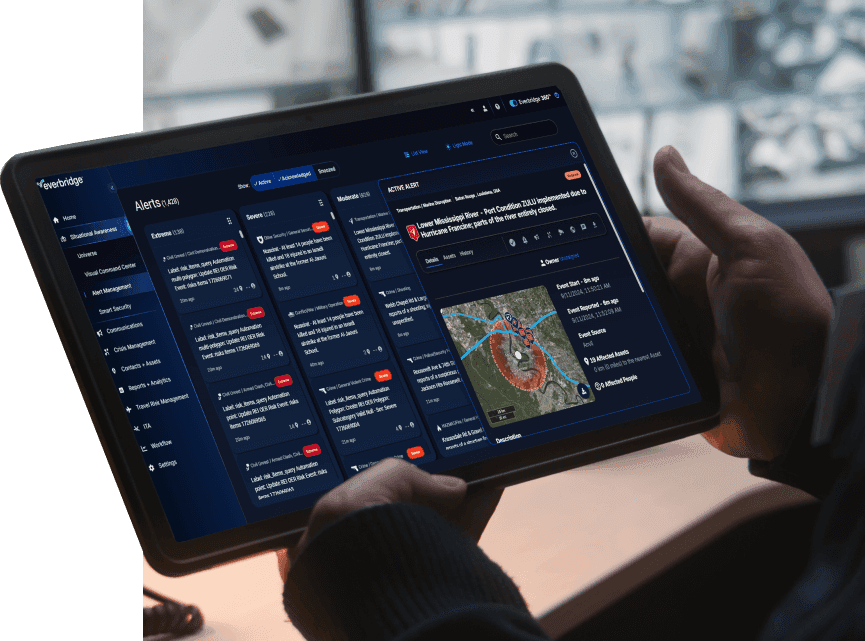AI is reshaping the way we approach security and crisis management. We spoke with Sharada Achanta, our VP of Product Management, about how this technology is driving faster, smarter responses to risks while raising important questions about ethics and responsibility.
AI is transforming security and risk intelligence. Where do you see the biggest impact?
AI is making security faster and smarter. The biggest impact is in how quickly organizations can detect, analyze, and respond to threats. AI can process massive amounts of data in real-time, identifying risks humans might miss. Whether it’s cybersecurity, physical security, or operational risk, AI helps teams move from reactive to proactive. Instead of waiting for an incident to happen, AI enables organizations to predict and mitigate risks before they escalate.
We’ve seen AI-driven threat detection systems stop cyberattacks before they spread. AI can help monitor network traffic, identify suspicious activity, and automatically take action to prevent breaches. In physical security, AI-powered surveillance systems analyze video feeds, detecting unusual behavior that might indicate a threat. AI also plays a role in disaster response, analyzing weather patterns and infrastructure risks to help emergency services prepare before crises unfold. These advancements aren’t just improving security, they’re saving lives and protecting assets.
Responsible AI is a growing concern. How can organizations ensure AI is used ethically in crisis management?
AI is only as good as the data it learns from. Bias, misinformation, and blind reliance on automation can create serious risks. Organizations need clear guidelines on how AI models are trained, tested, and used. Transparency is key—AI shouldn’t be a black box. Human oversight is essential. AI should assist decision-making, not replace it. Regular audits, diverse data sources, and clear accountability help ensure AI is ethical and reliable.
One major issue is data bias. If AI systems are trained on incomplete or skewed data, they can make flawed decisions. This is especially dangerous in security and crisis management. Organizations must invest in diverse datasets and regularly test AI models for unintended biases (1). Ethical AI governance means being transparent about how AI makes decisions and ensuring that humans are always in the loop. AI should provide insights, but final decisions should remain with experienced professionals who can factor in context and nuance.
What are some real-world examples of AI improving public safety?
AI is already making a difference. Emergency management teams use AI to analyze weather patterns and predict disasters, giving communities more time to prepare. AI-powered surveillance helps law enforcement detect threats in real-time. In cybersecurity, AI detects and neutralizes attacks before they spread. The key is integration—AI doesn’t work in isolation, it works alongside human expertise to enhance decision-making.
Take wildfire detection, for example. AI analyzes satellite imagery, weather conditions, and ground sensors to detect fire risks before they spread. Law enforcement agencies use AI-driven analytics to detect crime patterns and allocate resources where they’re needed most. AI is also helping hospitals manage emergency response, using predictive analytics to anticipate surges in patient volume during crises. These examples show how AI isn’t just reacting to events—it’s helping organizations plan ahead and reduce risks before they become emergencies.
How does AI help government agencies and public sector organizations manage risk?
Government agencies handle vast amounts of data. AI helps filter out noise and focus on what matters. AI-driven analytics can assess threats, streamline emergency response, and even detect fraud. Public sector organizations use AI to monitor infrastructure, flagging vulnerabilities before they lead to failures. The biggest advantage is speed—AI helps agencies act faster and with better information, improving outcomes for communities.
For instance, AI-driven threat intelligence helps governments track geopolitical risks, cyber threats, and public safety concerns in real time. AI-powered fraud detection systems help identify anomalies in financial transactions, preventing large-scale fraud in social programs. AI is also being used in smart city initiatives, analyzing traffic patterns to improve emergency response times (2). These applications show how AI is enabling governments to be more agile and proactive in protecting citizens.
Looking ahead, what’s the future of AI in security and crisis management?
AI will become more predictive, more integrated, and more responsible. Organizations that invest in AI now will be better positioned to handle future crises. The challenge is balancing speed with ethics—ensuring AI is transparent, fair, and accountable. The future isn’t just about AI making decisions, it’s about AI working as a trusted partner in risk intelligence, public safety, and crisis response.
We’ll see AI playing a bigger role in autonomous security systems, automating responses to threats before they escalate. AI will also improve risk intelligence platforms, using real-time data to give leaders more accurate insights. Regulation will continue to evolve, pushing organizations to adopt more responsible AI practices. AI will be an essential tool in security and crisis management, but it must be used with oversight and responsibility. Organizations that get this balance right will be the ones leading the way in resilience and preparedness.
Footnotes:
1. Forrester’s 2023 data shows that genAI’s potential for hallucinations, errors, and bias are among AI decision-makers’ top concerns, and they curtail business executives’ trust in AI.
Source: Align By Design (Or Risk Decline) – Forrester
2. “In critical areas such as public safety and emergency response, AI agents can analyze real-time data to provide insights, potentially leading to safer communities and more effective crisis management.”
Source: US Federal Workforce Layoffs: Can AI Agents Step In? – Forrester


